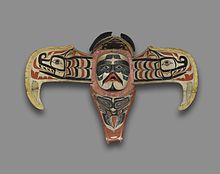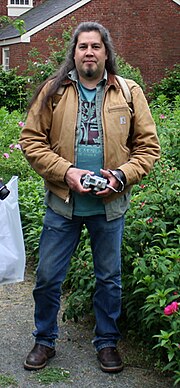Types of Arts and Crafts Did the Northwest Arctic Native

Totem Poles, a type of Northwest Declension fine art
Northwest Coast art is the term commonly practical to a style of fine art created primarily by artists from Tlingit, Haida, Heiltsuk, Nuxalk, Tsimshian, Kwakwaka'wakw, Nuu-chah-nulth and other Showtime Nations and Native American tribes of the Northwest Coast of North America, from pre-European-contact times up to the nowadays.
Distinguishing characteristics [edit]

Namgis, Thunderbird Transformation Mask, 19th century. The Thunderbird is believed to be an Bequeathed Sky Being of the Namgis clan of the Kwakwaka'wakw, who say that when this bird ruffles its feathers, it causes thunder and when information technology blinks its eyes, lightning flashes. Brooklyn Museum
Two-dimensional Northwest Coast fine art is distinguished by the use of formlines, and the use of characteristic shapes referred to as ovoids, U forms and S forms. Before European contact, the most common media were wood (often Western cherry-red cedar), stone, and copper; since European contact, paper, canvas, glass, and precious metals have also been used. If paint is used, the most common colours are red and black, but yellow is likewise often used, specially amidst Kwakwaka'wakw artists.[ane] Chilkat weaving applies formline designs to textiles. Tlingit, Haida, and Tsimshian have traditionally produced Chilkat woven regalia, from wool and yellow cedar bark, that is important for civic and ceremonial events, including potlatches.
The patterns depicted include natural forms such as bears, ravens, eagles, orcas, and humans; legendary creatures such as thunderbirds and sisiutls; and abstract forms made up of the characteristic Northwest Coast shapes. Totem poles are the well-nigh well-known artifacts produced using this fashion. Northwest Coast artists are besides notable for producing characteristic "aptitude-corner" or "bentwood" boxes, masks, and canoes. Northwest Coast designs were likewise used to decorate traditional Get-go Nations household items such equally spoons, ladles, baskets, hats, and paddles; since European contact, the Northwest Coast art manner has increasingly been used in gallery-oriented forms such as paintings, prints and sculptures.

Mary Ebbets Hunt - Chilkat blanket
Although highly conventionalized decorative pattern occurs all forth the coast, to the s and north of this center the representational motive becomes progressively stronger. Krickeberg (1925: 144) characterizes this as a fresh naturalism to the south among the Kwakiutl, Nootka, and Salish and a sure relationship to Eskimo engraving and painting among the Tlingit to the northward. The shift in accent is gradual - Bella Bella fine art, for instance, has a close affinity to its Coast Tsimshian analogue. Two-dimensional art of all these groups, however, is much more closely related than is their sculpture, especially among the northern tribes of Tlingit, Haida, Tsimshian, and Bella Bella.[two]
Textile arts from the Northwest Coast include Chilkat weaving, Raven'southward Tail Weavings, Push Blankets, and elaborate ceremonial regalia using a range of materials. Three dimension fine art was created from many materials, notably wood.
History [edit]

Prior to contact with Europeans, First Nations on the Northwest declension evolved circuitous social and ceremonial institutions, including the potlatch system, hereditary systems of rank and descent, ceremonial societies, and permanent villages. Social organization involved groups of kin, reckoned variously matrilineally, patrilineally or bi-lineally. These groups hold various tangible and intangible rights and properties. Amidst them are origin stories. Many instances of Northwest coast art are visual references to these stories.
After European contact, in the belatedly 18th century, the peoples who produced Northwest Coast art suffered huge population losses due to diseases such as smallpox, and cultural losses due to colonization and assimilation into European-North American culture. The production of their art dropped drastically besides.
Toward the cease of the 19th century, Northwest Coast artists began producing piece of work for commercial sale, such as small argillite carvings. The end of the 19th century also saw large-scale export of totem poles, masks and other traditional art objects from the region to museums and individual collectors effectually the world. Some of this export was accompanied by fiscal compensation to people who had a correct to sell the art, and some was not.
In the early 20th century, very few Start Nations artists in the Northwest Declension region were producing fine art. A tenuous link to older traditions remained in artists such as Charles Gladstone, Henry Speck, Ellen Neel, Stanley George, and Mungo Martin. The mid-20th century saw a revival of interest and production of Northwest Declension fine art, due to the influence of artists and academics such as Bill Reid (a grandson of Charles Gladstone) and Nib Holm. A revival of traditional ceremonial means also drove the increased product of traditional arts. This time besides saw an increasing need for the return of fine art objects that were illegally or immorally taken from First Nations communities. This demand continues to the present day. Today, there are numerous art schools teaching formal Northwest Declension art of various styles, and there is a growing market place for new art in this manner.[3]
The revival of formalism life, following the lifting of the potlatch ban - have besides driven production of traditional vesture, painting and carving for use in ceremonies.
Cultural appropriateness [edit]

Although neighbouring peoples such equally the Coast Salish peoples also traditionally produced fine art which shares some characteristics of Northwest Coast art, these styles of art are non usually included in the term, since the patterns and artifacts produced are rather different. For example, Salish peoples traditionally created standing welcome figures not created past other Northwest Declension peoples, did not traditionally create totem poles, and did not traditionally apply the form lines and shapes of other Northwest Declension peoples.[5] One corollary of this fact is that — contrary to popular conventionalities — other than some of the peoples of the Olympic Peninsula, no Native American nations of Washington and Oregon states produced totem poles and other characteristic, formline, Northwest Coast-style art objects before European contact.[6]
Traditionally, within a given community, some patterns and motifs could be used just by certain families and lineages, or with the understanding of those families and lineages. Today, in British Columbia, it is a point of contention whether merely First Nations artists of the appropriate nation have the moral correct to produce fine art of given types and using given motifs, or whether only the intent of the person and the respect given to the respective peoples are meaning. Too, in Ontario, similar controversies accept arisen over whether not-Native artists have the moral right to brand employ of Native motifs and visual art styles.[seven] Some non-Native artists, such as John Livingston, have been adopted into First Nations and have thus formally caused the right to produce such art.[1] In some nations, such every bit the Haida, adoptions are seen past some only every bit gestures, and production of piece of work in their trademark style by outsiders may, in some contexts, be viewed as economic and cultural appropriation.[ citation needed ]
Notable artists [edit]
Notable Northwest Coast artists of the 19th century include- Albert Edward Edenshaw[8] (Haida), Captain Carpenter[nine] (Heiltsuk), Willie Seaweed (Kwakwak'wakw), Charles Edenshaw, who is widely acknowledged equally a main whose fine art is in all the swell collections around the globe.
Also Guujaaw, another notable carver and builder who is besides Haida political leader. Other notable Northwest Coast artists of the 20th and 21st centuries include Charlie James, Henry Speck, Doug Cranmer, Stanley George, James Schoppert, Bill Reid, Mungo Martin, Ellen Neel, Robert Davidson, Beau Dick, Willie Seaweed, Roy Henry Vickers, Don Yeomans, Jay Simeon, Amos Wallace, Lyle Wilson, Sam (Sammy) Robinson, Ron Hamilton, Art Thompson, Joe David, Reginald Peterson,[ten] Freda Diesing, Lawrence Paul Yuxweluptun, and Tony Hunt.
Notable art historians and thinkers [edit]
Notable academics and publishers of northwest Northwest Coast include Beak Holm, Bill Reid, Hilary Stewart, Beak McLennan, Martha Black, and George F. MacDonald. Doreen Jensen and Polly Sargent'south volume Robes of Power (1986) deals with ceremonial robes - called Button blanket - and their history and forms. Cheryl Samuel and her book The Raven'southward Tail (1987) describes northern weaving way known as Raven's Tail - used to make ceremonial robes and other regalia.
Emily Carr, though she did non formally adopt the techniques, commonly used native fine art as the motif of many of her early on paintings.
See besides [edit]
- Alaska Native art
- Button coating
- Chilkat weaving
- Coast Salish art
- Formline fine art
- Haida argillite carvings
- Kwakwaka'wakw fine art
- Native American art
- Potlatch
- Totem pole
- Transformation mask
Notes [edit]
- ^ a b Bill Holm, Northwest Coast Indian Art: An Assay of Form. University of Washington Printing, Seattle, 1965
- ^ Holm, Bill. Northwest Coast Indian Art: An analysis of Class. Thomas Burke Memorial Washington State Museum Monograph No. 1. Douglas & McIntyre. Vancouver/Toronto. 1965. p. xx. ISBN 0-88894-172-two
- ^ Jonathan Meuli. Shadow House: Interpretations of Northwest Coast Art ISBN xc-5823-083-10
- ^ "Tommy Joseph." Archived 2009-06-fifteen at the Wayback Machine Alaska Native Artists. (retrieved 27 Dec 2009
- ^ Hilary Stewart. Looking at Totem Poles. Douglas & McIntyre, Vancouver/Toronto, 1993
- ^ Hilary Stewart,Looking at Indian Art of the Northwest Coast. Douglas & McIntyre, Vancouver/Toronto, 19795
- ^ Nasser, Shanifa. "Toronto gallery cancels testify after concerns artist 'bastardizes' Indigenous art". CBC . Retrieved 21 September 2018.
- ^ MacDonald, George F. Haida Art. Joe Wilson. University of Washington Press. Seattle. 1996. p.p. 211-212. ISBN 0-295-97561-X
- ^ McLennan, Neb and Karen Duffek. The Transforming Image: Painted Arts of the Northwest Coast Commencement Nations. UBC Press. 2000. ISBN 0-7748-0427-0
- ^ Fair, Susan W. (2006). Alaska native art : tradition, innovation, continuity. Fairbanks, Alas.: Univ. of Alaska Press. ISBN1-889963-79-8.
References [edit]
- Halpin, Marjorie M. (1981). Totem Poles: An Illustrated Guide . Vancouver: Academy of British Columbia Press.
- Jensen, Doreen; Sargent, Polly. Robes of Power: Totem Poles on Textile. ISBN0-7748-0264-ii.
- Jonaitis, Aldona; Boas, Franz. A Wealth of Thought: Franz Boas on Native American Art . ISBN0-295-97325-0.
- MacDonald, George F. (1996). Haida Fine art. Seattle: University of Washington Press. pp. 211–212. ISBNi-550-54402-0.
- McLennan, Neb; Duffek, Karen (2000). The Transforming Image: Painted Arts of the Northwest Declension Outset Nations. UBC Printing. ISBN0-7748-0427-0.
- Ostrowitz, Judith. Privileging the Past. Academy of Washington Press. ISBN0-295-97814-7.
Farther reading [edit]
- Malin, Edward (1999). Northwest Coast Indian Painting: House Fronts and Interior Screens. Timber Printing. ISBN978-0-88192-471-8.
- Duff, Wilson (1964). The Indian History of British Columbia: Volume 1 The Bear on of the White Man. Province of British Columbia Section of Recreation and Conservation.
External links [edit]
- Bill Holm Center for the Study of Northwest Coast Fine art at the Burke Museum
- Reciprocal Research Network
Source: https://en.wikipedia.org/wiki/Northwest_Coast_art
0 Response to "Types of Arts and Crafts Did the Northwest Arctic Native"
Post a Comment